Research on the Development Mechanism of Air Thermal Miscible Flooding in the High Water Cut Stage of Medium to High Permeability Light Oil Reservoirs
Abstract
1. Introduction
2. Experiments
2.1. Experimenta Materials
- (1)
- Oil sample: The crude oil is first filtered through a 200-mesh stainless steel screen at temperatures below 80 °C and then dehydrated at 130 °C to ensure a water content below 0.3%. The viscosity of the degassed crude oil at surface conditions is 20 mPa·s, and the viscosity of the underground crude oil ranges from 5~6 mPa·s.
- (2)
- Quartz sand: Three types of quartz sand with particle sizes of 80 mesh, 100 mesh, and 160 mesh were utilized.
- (3)
- Experimental water: Distilled water was utilized in this experiment.
- (4)
- Experimental Gases: The purity of nitrogen and carbon dioxide used in the experiment is greater than 99.9%. The mass content of impurities in the air, such as water vapor, dust, and oil, does not exceed 0.5%.
2.2. Experimental Apparatus
- (1)
- Injection system: The system is primarily used for the stable injection and accurate measurement of various fluids. It consists of an ISCO pump, gas cylinders, a gas pressure reducing valve, and a gas mass flow controller. (1) ISCO pump: It can achieve precise liquid injection in the range of 0–20 mL/min, with a control accuracy of 1%FS. (2) Gas cylinder: It must provide a stable air source with a pressure higher than the experimental design pressure of 1 MPa, with a maximum pressure of 30 MPa. (3) Gas pressure reducing valve: It can achieve a stable gas supply to the downstream manifold, maintaining a pressure fluctuation range of less than 1%FS. (4) Gas mass flow controller: It can achieve quantitative gas supply within the range of 0–10 L/min, with a control gas flow accuracy of 0.5%FS.
- (2)
- Reservoir Simulation System: The system is primarily used to simulate the underground environment of the reservoir, ensuring the accuracy of the experiment. It consists of a back pressure valve, a sand pipe, and a wall heater. (1) Back Pressure Valve: It can be used to simulate high-pressure environments, with a pressure range of 0.0–15.0 MPa. (2) Combustion Tube Model: The combustion tube has a length of 150 cm, an inner diameter of 6.4 cm, and a wall thickness of 3 mm. Its operating temperature range is –20 to 650 °C. (3) Wall Heater: It can rapidly heat the wall of the combustion tube model, achieve real-time temperature tracking, and ensure that the difference between the wall surface temperature of the model tube and the core temperature is less than 5 °C. This fully simulates the insulating ability of the formation. The heater has a power rating of 600 W, a width of 6.5 cm, and a total length of 24 cm.
- (3)
- Data Acquisition System: The system is primarily used for the collection and storage of data and consists of a temperature sensor, a pressure sensor, a gas component analyzer, and a data acquisition and processing system. (1) Temperature Sensor: This experiment uses a K-type thermocouple, which is installed along with heating tiles on the outer wall of the sand-filled pipe. Its accuracy is ±1 °C, and the measurement range is −20 to 1300 °C, with a total of 47 sensors. (2) Gas Component Analyzer: It performs online detection of CO, CO2, N2, H2, and O2 gas volume percentage content, with an accuracy of ±0.5% FS. (3) Data Acquisition Processor: With a minimum data acquisition interval of 1 s, it can achieve accurate measurement of data.
2.3. Experimental Scheme and Procedure
- (1)
- Sand packed model filling and porosity measurement: The experimental sand was evenly and tightly packed into the model. After the sand filling is completed, the air in the sand-filled pipe is evacuated using a vacuum pumping device. When the pressure in the sand-filled tube drops below 10 Pa, the injection section of the tube is connected to an intermediate vessel filled with water, allowing enough experimental water to be automatically drawn into the model. The volume of the saturated water and the porosity are then calculated.
- (2)
- Saturated crude oil: Experimental oil is used to displace water in a sand-filled tube model. When the oil content of the produced liquid reaches 99.0%, the amount of oil injected and the amount of water produced are precisely measured. Subsequently, the initial oil saturation and irreducible water saturation are calculated.
- (3)
- Water flooding: Water flooding is conducted according to the experimental requirements. When the water cut of the produced liquid reaches 95%, the displacement is halted to calculate the output oil volume and determine the recovery degree of water flooding. The saturated crude oil and water flooding parameters of the experiment are presented in Table 3.
- (4)
- Establish the initial temperature: To ensure the internal temperature of the combustion tube meets the experimental setting, the tube’s wall heater is heated to the designated temperature and maintained for over 4 h.
- (5)
- Displacement Experiment: According to the experimental design, different types of gas are injected to perform development experiments at the high water cut stage using various displacement methods. Data such as gas flow rate, temperature measurement point temperatures, and exhaust gas composition are recorded in real time. At fixed time intervals, the produced liquid in the gas–liquid separator is collected in different glass containers for detection and measurement.
- (6)
- Repeat the aforementioned steps to complete all experiments.
2.4. Results and Discussion
- (1)
- Analysis of temperature in the thermal miscible flooding
- (2)
- Analysis of produced gas component in the thermal miscible flooding
- (3)
- Comparative analysis of production dynamics for different gas flooding methods
3. Numerical Simulation Study of Thermal Miscible Flooding
3.1. Establishment of Numerical Models
3.2. Results and Discussion
4. Conclusions
Author Contributions
Funding
Data Availability Statement
Conflicts of Interest
References
- Xue, L.; Liu, P.; Zhang, Y. Status and Prospect of Improved Oil Recovery Technology of High Water Cut Reservoirs. Water 2023, 15, 1342. [Google Scholar] [CrossRef]
- He, L.; Shujun, B.; Zixiu, Y.; Fuchao, S.; Jiaqing, Y.; Deli, J.; Yang, G. Practices of the Integrated Management System for Injection Water in Brown Field–Case Study. In Proceedings of the SPE Asia Pacific Oil & Gas Conference and Exhibition, Perth, Australia, 25–27 October 2016. [Google Scholar]
- Jamaloei, B.Y. Effective Conformance Control Strategies in Mature Waterfloods with Comingled Injection. In Proceedings of the SPE Annual Technical Conference and Exhibition, Houston, TX, USA, 3–5 October 2022. [Google Scholar]
- Lu, X.G.; Sun, S.Q.; Xu, J.H. Best Practice Case to Improve Oil Recovery: Revisit of the Largest Oilfield in China. In Proceedings of the SPE Caspian Technical Conference and Exhibition, Astana, Kazakhstan, 26–28 November 2024. [Google Scholar]
- Moradpour, H.; Chapoy, A.; Tohidi, B. Bimodal model for predicting the emulsion-hydrate mixture viscosity in high water cut systems. Fuel 2011, 90, 3343–3351. [Google Scholar] [CrossRef]
- Lin, H.; Hua, C.Z.; Li, M. Surface wettability control of reservoir rocks by brine. Pet. Explor. Dev. 2018, 45, 145–153. [Google Scholar] [CrossRef]
- Ma, K.; Sun, Z.; Shi, H. Maximize the Recovery Factor of Offshore High Water Cut Reservoir. In Proceedings of the Offshore Technology Conference, Houston, TX, USA, 6–9 May 2019. [Google Scholar]
- Amaro, I.P.; Chelhod, N.C.-Y.; Laprea-Bigott, M. Workflow for Optimization of Waterflood Performance: Field Example from El Furrial Field—East Venezuela Basin. In Proceedings of the SPE Latin American and Caribbean Petroleum Engineering Conference, Bogota, Colombia, 17–19 March 2020. [Google Scholar]
- Zhu, Y.; Gao, W.; Li, R.; Li, Y.; Yuan, J.; Kong, D.; Liu, J.; Yue, Z. Action laws and application effect of enhanced oil recovery by adjustable-mobility polymer flooding. Pet. Explor. Dev. 2018, 39, 189–200. [Google Scholar]
- Wei, Y.; Lu, X.; Xu, J. A Systematical Review of the Largest Alkali-Surfactant-Polymer Flood Project in the World: From Laboratory to Pilots and Field Application. SPE J. 2024, 29, 4147–4165. [Google Scholar] [CrossRef]
- Mahruqi, D.; Karpan, V.; Rawahi, H.; Abri, M.; Aamri, N.; Farsi, S.; Battashi, M.; Amri, S. Integrating ASP Flooding into Mature Polymer Flooding in Marmul Field in Southern Oman. In Proceedings of the SPE Conference at Oman Petroleum & Energy Show, Muscat, Oman, 22–24 April 2024. [Google Scholar]
- Gan, L.; Dai, X.; Zhang, X.; Li, L.; Du, W.; Liu, X.; Gao, Y.; Lu, M.; Ma, S.; Huang, Z. Key technologies for the seismic reservoir characterization of high water-cut oilfields. Pet. Explor. Dev. 2012, 39, 365–377. [Google Scholar] [CrossRef]
- Song, K.P.; Wang, C.C.; Fu, C.; Wu, X.H. The Research of Water Flooding Measures in Late High Water Cut Period of Secondary Reservoirs. Appl. Mech. Mater. 2014, 703, 308–311. [Google Scholar] [CrossRef]
- Zhao, X.J.; Zuo, S.L.; Wu, J.W. Study and application of strata and well pattern reconstruction technique at extra high water cut stage in Daqing Oilfield. Pet. Geol. Recovery Effic. 2019, 26, 82–87. [Google Scholar]
- Wang, H.; Hou, J.; Guo, Z.; He, S.; Du, Q.; Li, C. Evaluation of Different Well Converting Patterns with the Distribution of Streamlines on Ultra High Water Cut Reservoir. In Proceedings of the Offshore Technology Conference Asia, Kuala Lumpur, Malaysia, 48–55 November 2020. [Google Scholar]
- Liu, J.; Cheng, R.; Zhang, Z.; Chen, B. Numerical Simulation of N2 Foam Flooding in Medium-Permeability Light-Oil Reservoir with Ultra-High Water Cut. Chem. Technol. Fuels Oils 2017, 53, 286–295. [Google Scholar] [CrossRef]
- Gao, J.; Yao, Y.; Bao, H.; Shen, J. Laboratory Evaluation Experiment for Adaptability Analysis of Nitrogen Injection in Yanchang Oil Field. In Proceedings of the Abu Dhabi International Petroleum Exhibition & Conference, Abu Dhabi, United Arab Emirates, 15–18 November 2022. [Google Scholar]
- Jiang, T.; Zhou, D.; Lian, L.; Wu, Y.; Wu, Z.; Fan, K.; Zhou, W.; Bian, W.; Shao, G.; Fan, J.; et al. Research of Phase Behavior in Natural Gas Drive Process and Its Application in T_D Reservoir with HTHP. In Proceedings of the SPE Middle East Oil & Gas Show and Conference, Sanabis, Bahrain, 28 November 2021. [Google Scholar]
- Zhang, Y.; Li, B.; Lu, T.; Li, Z.; Zeng, X.; Song, Y. Adaptation study on nitrogen foam flooding in thick reservoirs with high water cut and high permeability. Colloids Surfaces A 2023, 657, 130539. [Google Scholar] [CrossRef]
- Srivastava, R.K.; Huang, S.S. Laboratory investigation of weyburn CO2 miscible flooding. In Proceedings of the Technical Meeting/Petroleum Conference of the South Saskatchewan Section, Regina, SK, Canada, 18–21 October 1997. [Google Scholar]
- Qin, J.; Zhang, K.; Chen, X. Mechanism of the CO2 flooding as reservoirs containing high water. Acta Pet. Sin. 2010, 31, 797–800. [Google Scholar]
- Wu, X.; Zhang, Y.; Zhang, K.; Liu, B.; Zuo, J.Y.; Chen, G. An experimental investigation of liquid CO2-in-water emulsions for improving oil recovery. Fuel 2020, 288, 119734. [Google Scholar] [CrossRef]
- Xi, C.; Wang, B.; Zhao, F.; Liu, T.; Qi, Z.; Zhang, X.; Tang, J.; Jiang, Y.; Guan, W.; Wang, H.; et al. Oxidization characteristics and thermal miscible flooding of high pressure air injection in light oil reservoirs. Pet. Explor. Dev. 2022, 49, 874–885. [Google Scholar] [CrossRef]
- Xi, C.; Wang, B.; Zhao, F.; Hua, D.; Qi, Z.; Liu, T.; Zhao, Z.; Tang, J.; Zhou, Y.; Wang, H. Miscibility of light oil and flue gas under thermal action. Pet. Explor. Dev. 2024, 51, 164–171. [Google Scholar] [CrossRef]
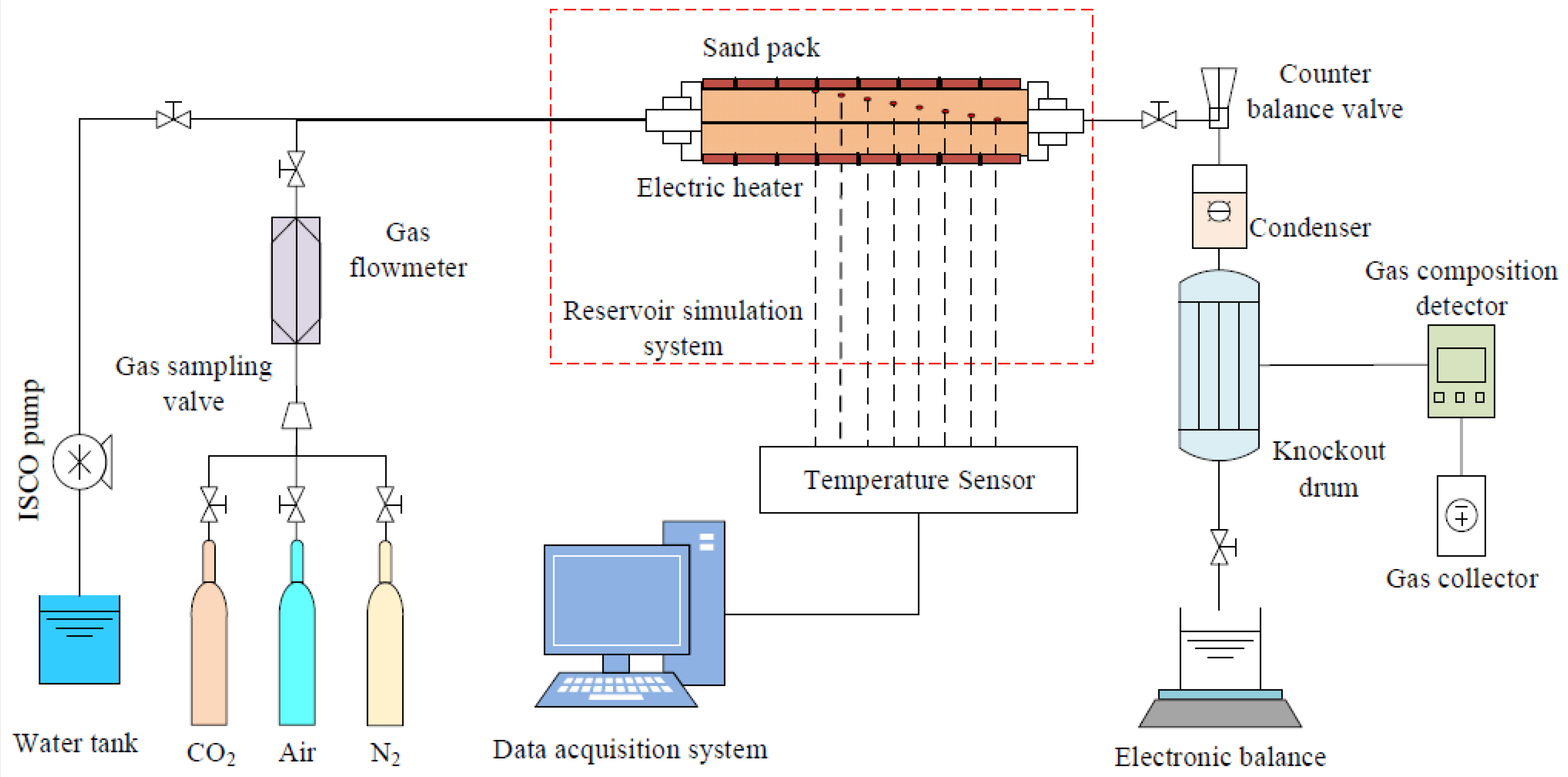
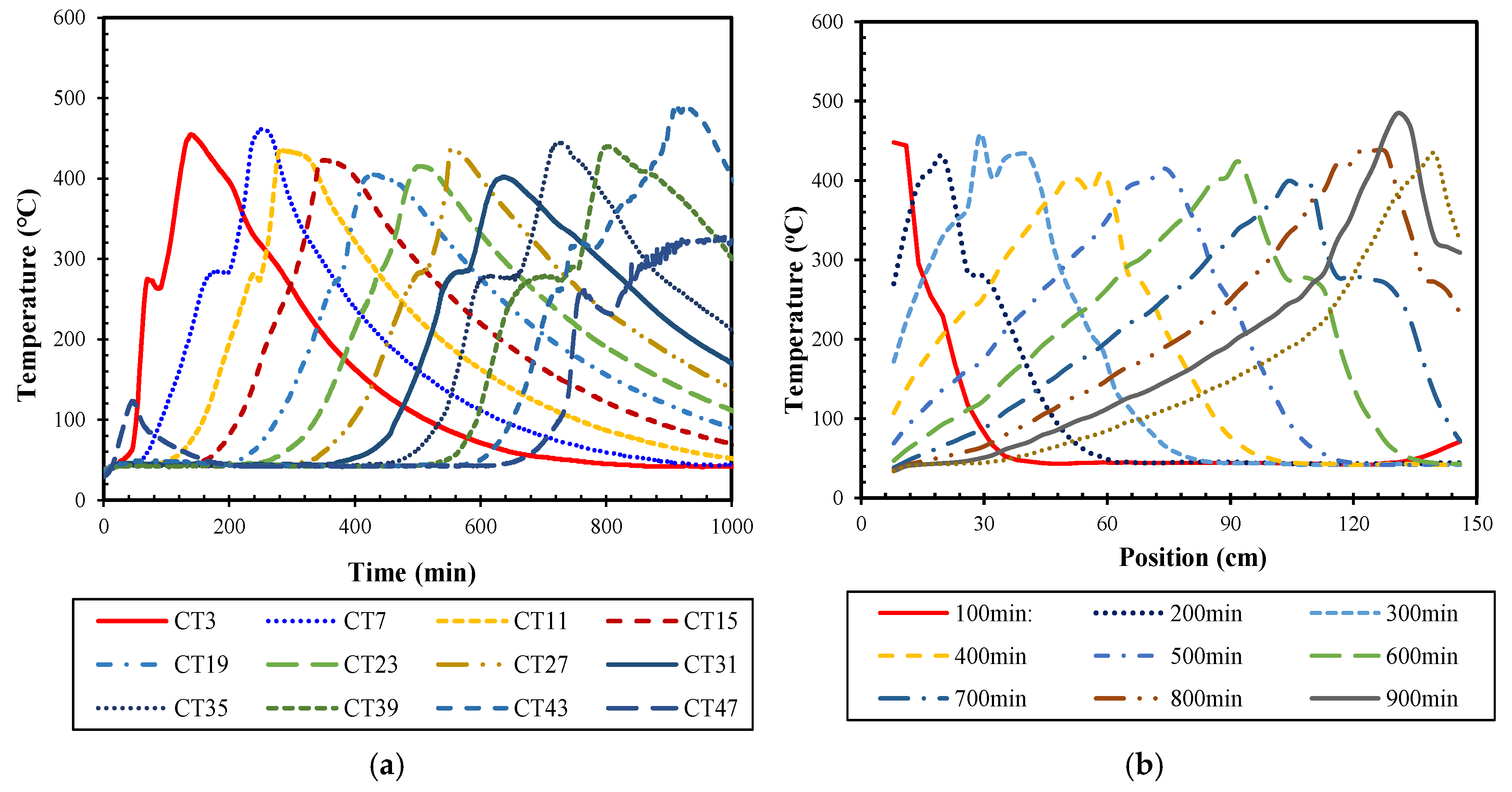
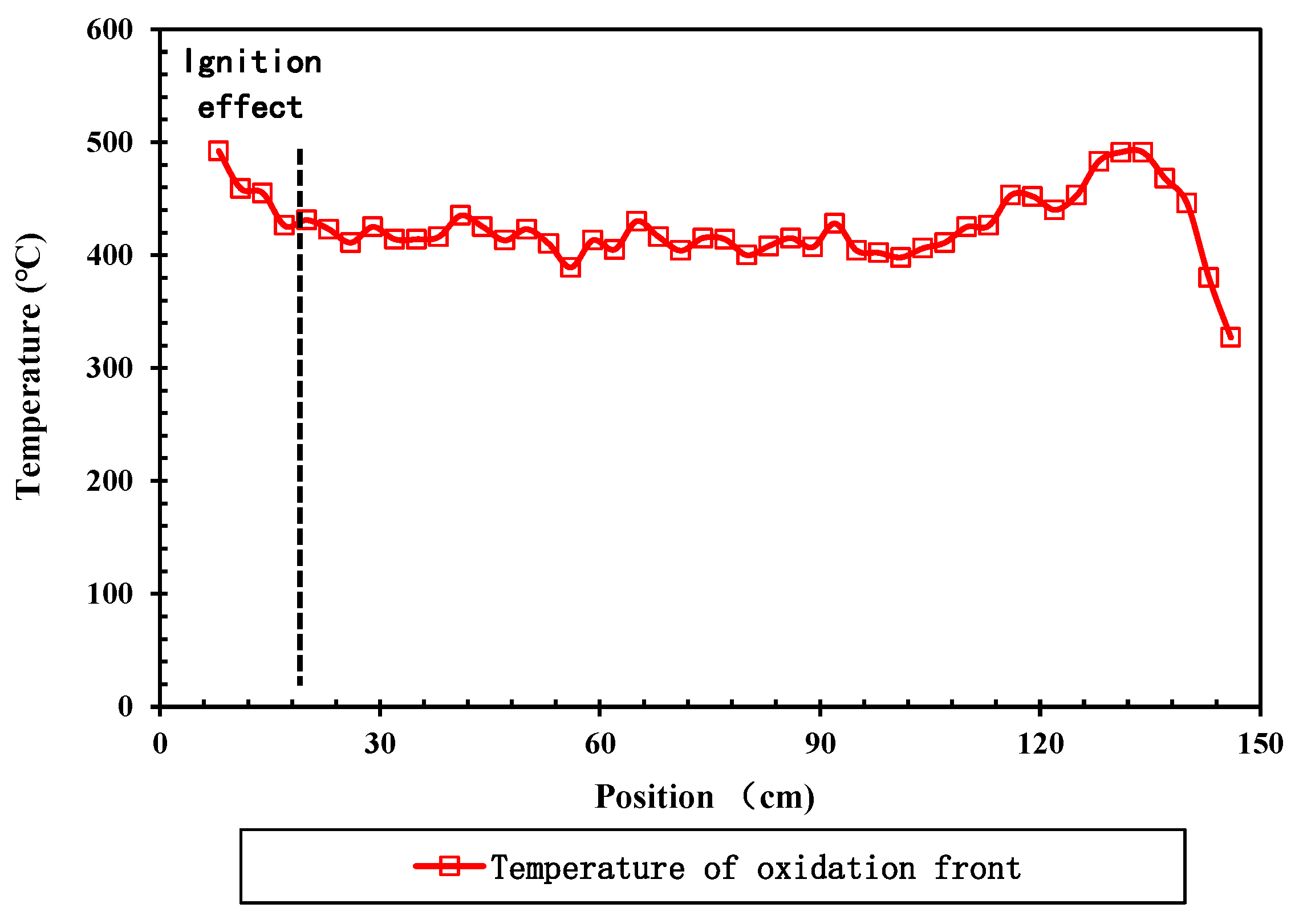
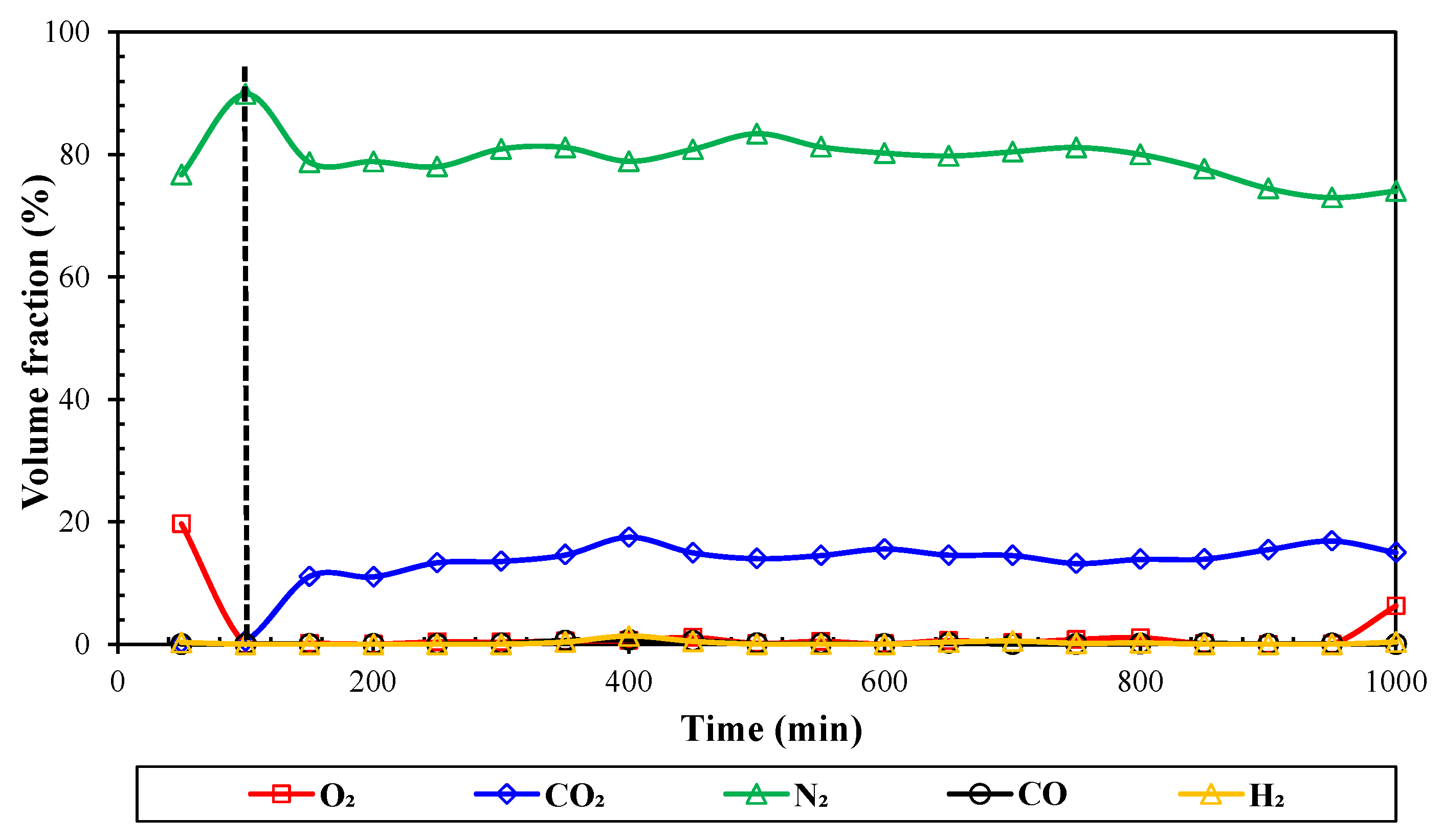
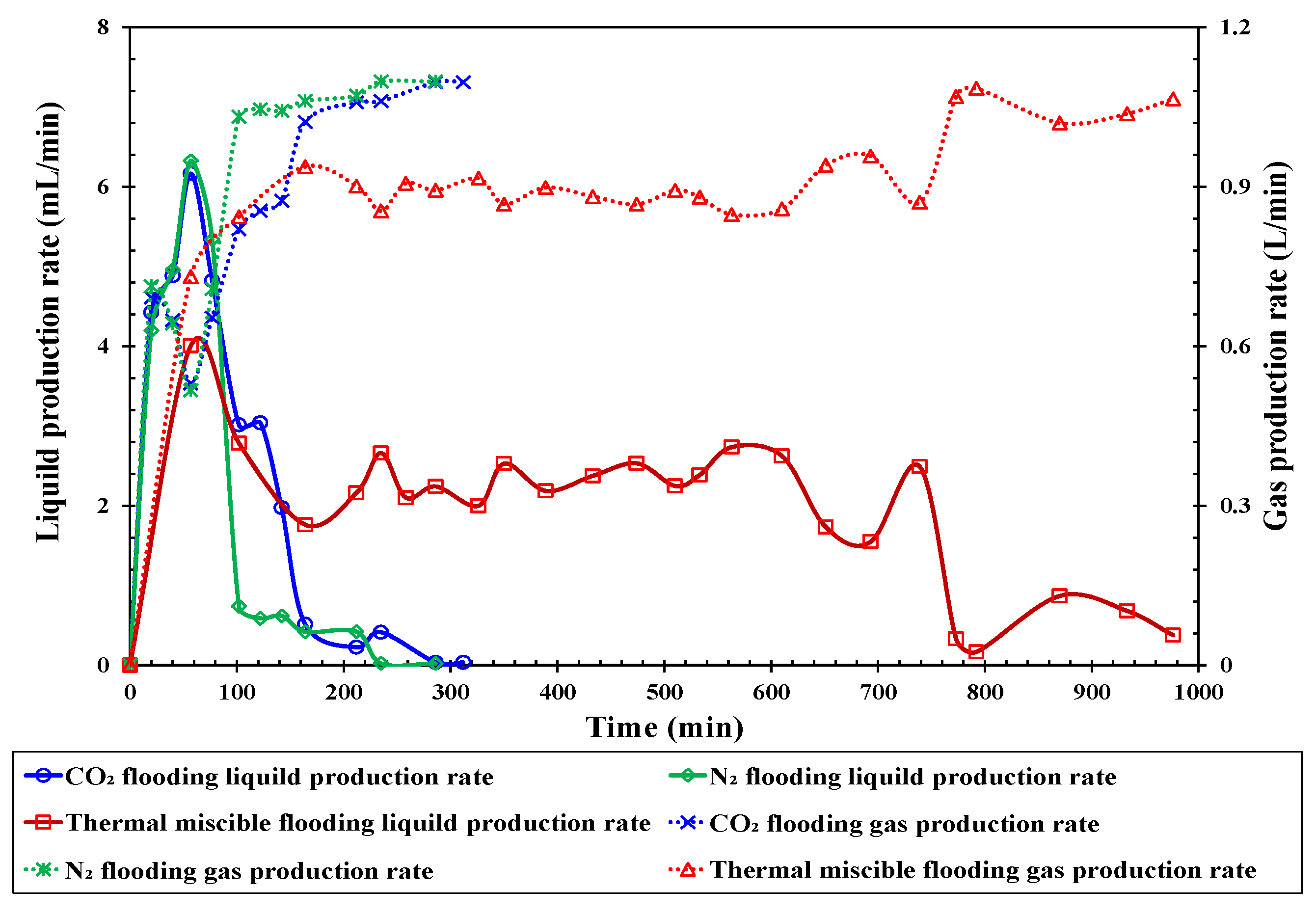

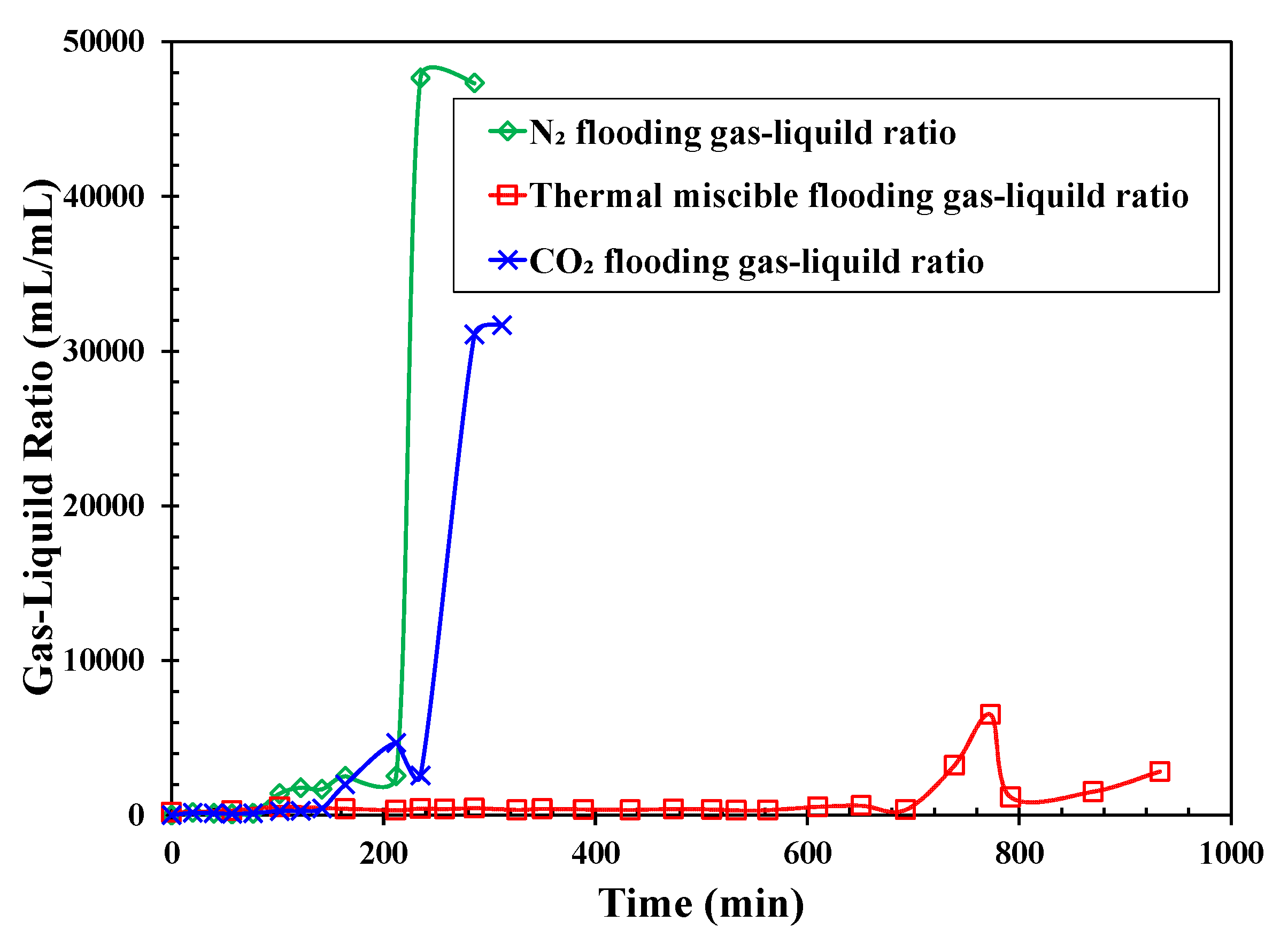

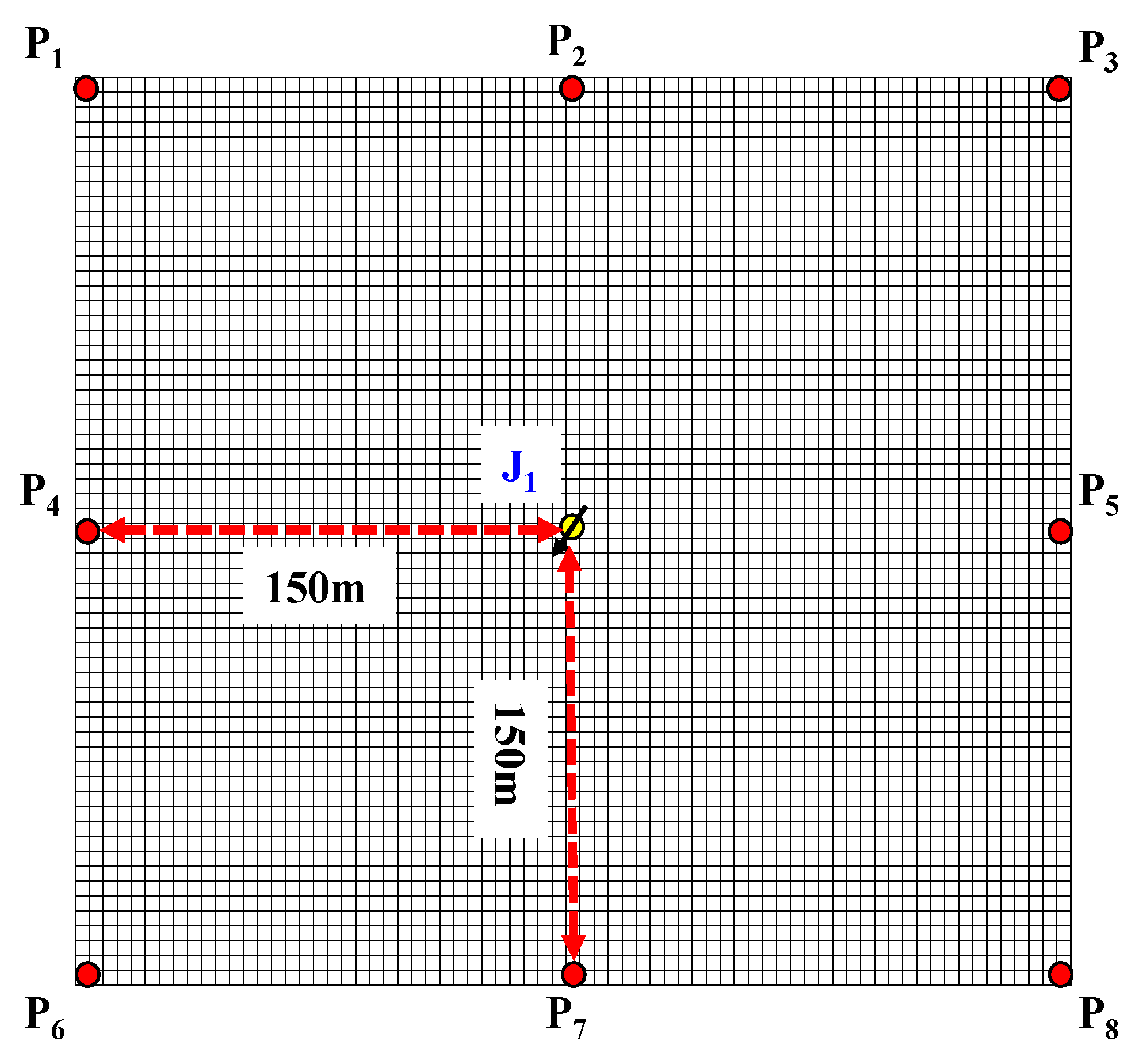
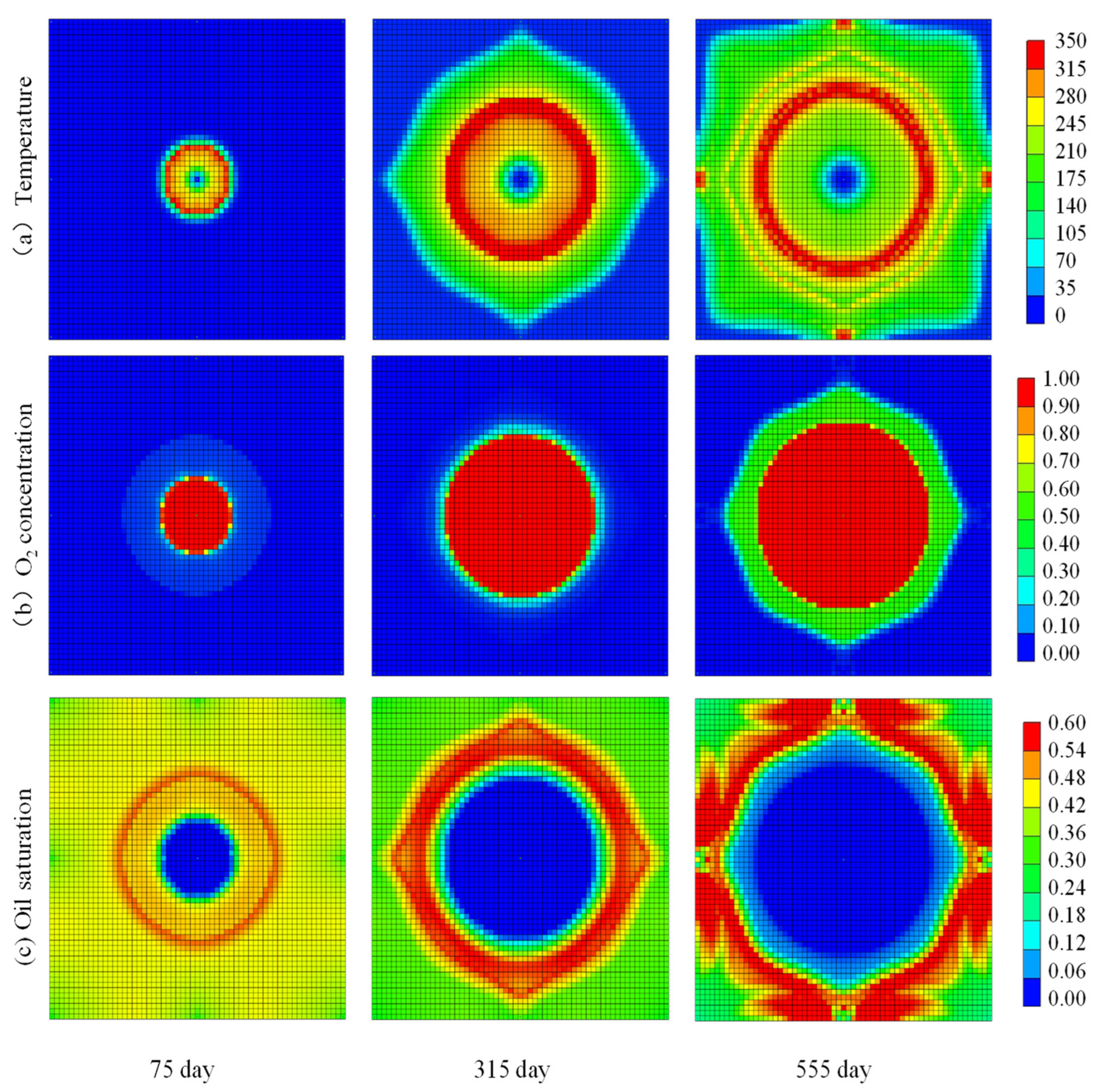
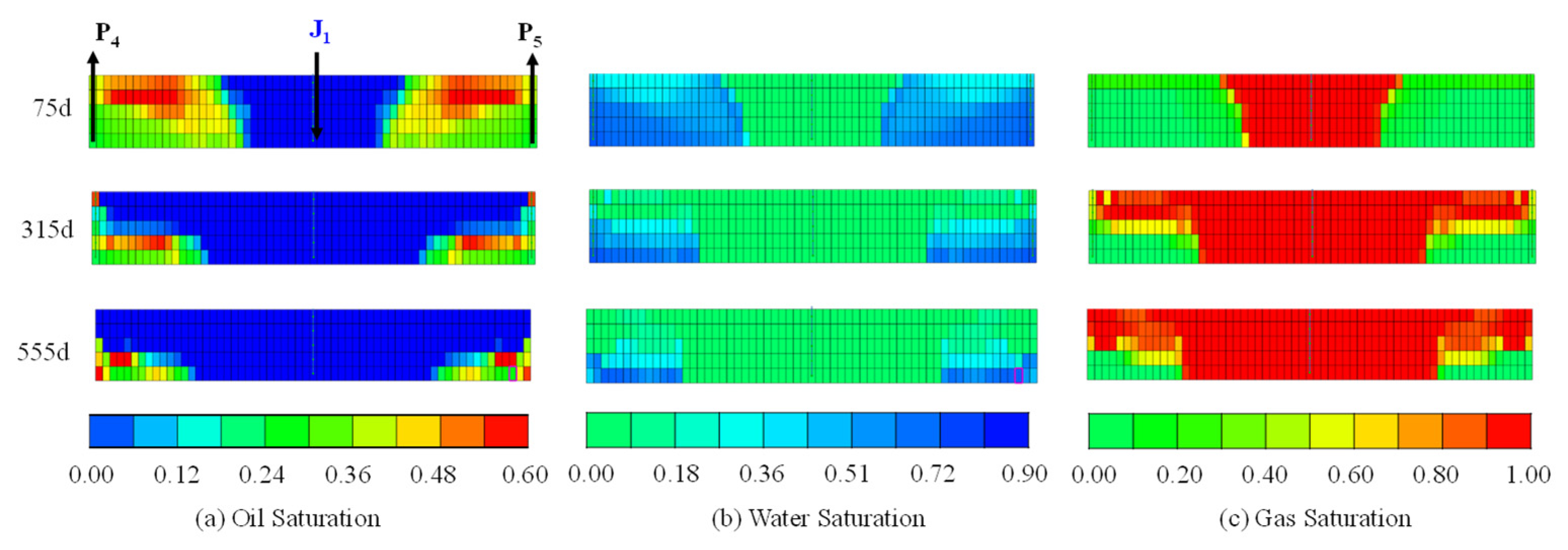

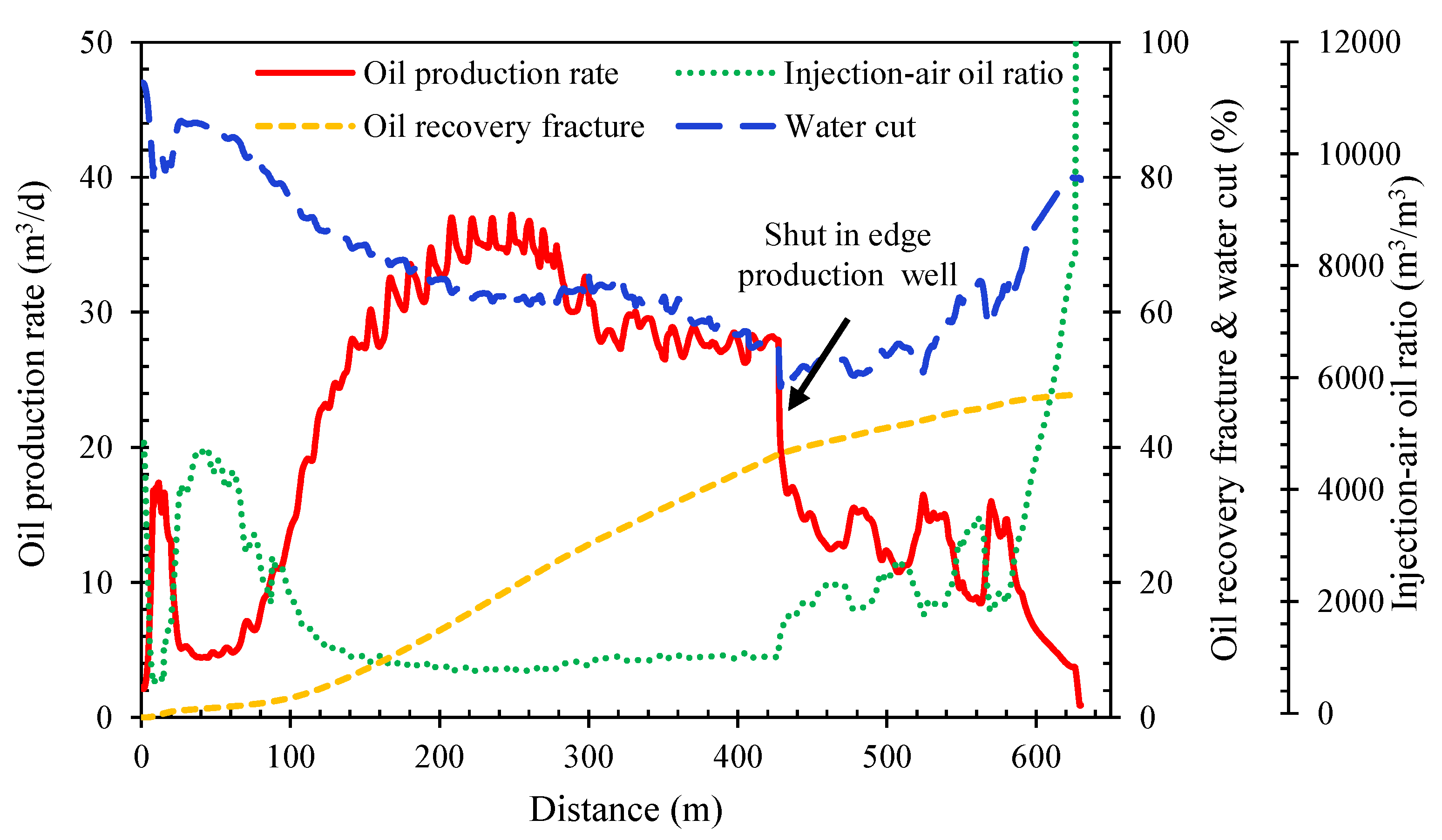
| Pressure range, MPa | 0~15 | Pressure accuracy, %FS | 0.25 |
| Temperature range, °C | 0~650 | Temperature accuracy, °C | ±1 |
| Porous media | Core, Glass beads, Quartz | Injection fluid | Gas, Water, Chemical reagents |
| No. | Temperature, °C | Pressure, MPa | Pressure, % | Gas Flooding Technologies | Gas Injection Rate, L/min |
|---|---|---|---|---|---|
| 1 | 45 | 10 | 50~55 | N2 flooding | 1.1 |
| 2 | 45 | 10 | 50~55 | CO2 flooding | 1.1 |
| 3 | 45 | 10 | 50~55 | Thermal miscible flooding | 1.1 |
| No. | Porosity, % | Injection Water, mL | Saturated Water, mL | Injection Oil, mL | Saturated Oil, mL | Oil Saturation, % | Water Flooding Recovery Factor, % |
|---|---|---|---|---|---|---|---|
| 1 | 39.6 | 4000.0 | 1909.9 | 3000.0 | 1608.1 | 84.2 | 52.89 |
| 2 | 38.9 | 3000.0 | 1876.2 | 3000.0 | 1587.3 | 84.6 | 53.26 |
| 3 | 38.5 | 3500.0 | 1856.9 | 3000.0 | 1589.5 | 85.6 | 53.02 |
| Parameters | Value |
|---|---|
| Grid Number | 61 × 61 × 7 |
| Reservoir Depth (m) | 1000.00 |
| Formation Thickness (m) | 70 |
| Initial Formation Pressure (MPa) | 10.00 |
| Formation Temperature (°C) | 45.00 |
| Formation Porosity (f) | 0.30 |
| Formation Permeability (mD) | 779.00 |
| Crude Oil Viscosity (@20 °C, mPa·s) | 10.00 |
| Initial Oil Saturation (%) | 55% |
| After Water Flooding Average Oil Saturation (%) | 30.00 |
| Heavy Component Ratio (%) | 0.16 |
| Parameters | Water | Heavy Oil | Light Oil | CO2 | CH4 | N2 | O2 | Coke |
|---|---|---|---|---|---|---|---|---|
| Molecular weight (g/mol) | 18.00 | 479.00 | 162.00 | 44.00 | 16.00 | 28.00 | 32.00 | 13.00 |
| Critical pressure (kPa) | 22,048 | 1496.49 | 2852.90 | 7376.46 | 4600 | 3394.39 | 506.62 | / |
| Critical tempareture (°C) | 374.15 | 962.02 | 321.56 | 31.05 | −82.55 | −146.95 | −118.55 | / |
| KV1 (kPa) | 0.00 | 0.00 | 3.95 × 106 | 8.621 × 108 | 5.455 × 105 | / | / | / |
| KV2 (°C) | 0.00 | 0.00 | 0.00 | 2.607 | 2.85 × 10−7 | |||
| KV3 (°C) | 0.00 | 0.00 | 0.00 | 6.141 | 54.46 | |||
| KV4 (°C) | 0.00 | 0.00 | −3999.90 | −3112 | −919.2 | / | / | / |
| KV5 (°C) | 0.00 | 0.00 | −273.15 | −191.2 | −149.9 | / | / | / |
| Reaction Equation | Pre-Exponential Factor (s−1) | Activation Energy (kJ/mol) | Heat of Reaction (kJ/mol, O2) |
|---|---|---|---|
| 13 heavy oil→26 light oil + 155 coke | 2.167 × 109 | 1.828 × 105 | 0.000 |
| 1 heavy oil+ 4 O2→6 water + 3 light oil + 1 CO2 + 1 coke | 1.51 × 106 | 4.058 × 104 | 2.127 × 106 |
| 2 light oil + 37O2→30 water + 22CO2 | 1.200 × 107 | 7.183 × 104 | 2.033 × 108 |
| 4 coke + 5O2→2 water + 4CO2 | 8.870 × 105 | 5.262 × 104 | 5.960 × 105 |
| Phase | Gas Injection Rate (m3/d) | Production and Injiection Ratio (f) | Injection Gas Composition Ratio (N2:O2:CO2) (f) |
|---|---|---|---|
| Starup phase | 25,000.00 | 0.85 | 0.79:0.21:0.00 |
| Stable phase | 50,000.00 | 0.85 | 0.79:0.21:0.00 |
Disclaimer/Publisher’s Note: The statements, opinions and data contained in all publications are solely those of the individual author(s) and contributor(s) and not of MDPI and/or the editor(s). MDPI and/or the editor(s) disclaim responsibility for any injury to people or property resulting from any ideas, methods, instructions or products referred to in the content. |
© 2025 by the authors. Licensee MDPI, Basel, Switzerland. This article is an open access article distributed under the terms and conditions of the Creative Commons Attribution (CC BY) license (https://creativecommons.org/licenses/by/4.0/).
Share and Cite
Hua, D.; Xi, C.; Liu, P.; Liu, T.; Zhao, F.; Wang, Y.; Du, H.; Gu, H.; Wu, M. Research on the Development Mechanism of Air Thermal Miscible Flooding in the High Water Cut Stage of Medium to High Permeability Light Oil Reservoirs. Energies 2025, 18, 2783. https://doi.org/10.3390/en18112783
Hua D, Xi C, Liu P, Liu T, Zhao F, Wang Y, Du H, Gu H, Wu M. Research on the Development Mechanism of Air Thermal Miscible Flooding in the High Water Cut Stage of Medium to High Permeability Light Oil Reservoirs. Energies. 2025; 18(11):2783. https://doi.org/10.3390/en18112783
Chicago/Turabian StyleHua, Daode, Changfeng Xi, Peng Liu, Tong Liu, Fang Zhao, Yuting Wang, Hongbao Du, Heng Gu, and Mimi Wu. 2025. "Research on the Development Mechanism of Air Thermal Miscible Flooding in the High Water Cut Stage of Medium to High Permeability Light Oil Reservoirs" Energies 18, no. 11: 2783. https://doi.org/10.3390/en18112783
APA StyleHua, D., Xi, C., Liu, P., Liu, T., Zhao, F., Wang, Y., Du, H., Gu, H., & Wu, M. (2025). Research on the Development Mechanism of Air Thermal Miscible Flooding in the High Water Cut Stage of Medium to High Permeability Light Oil Reservoirs. Energies, 18(11), 2783. https://doi.org/10.3390/en18112783





